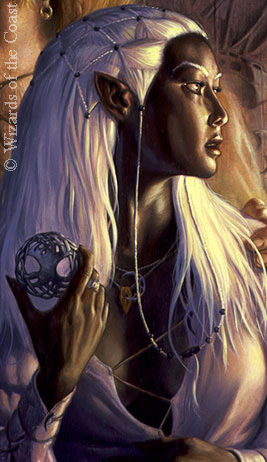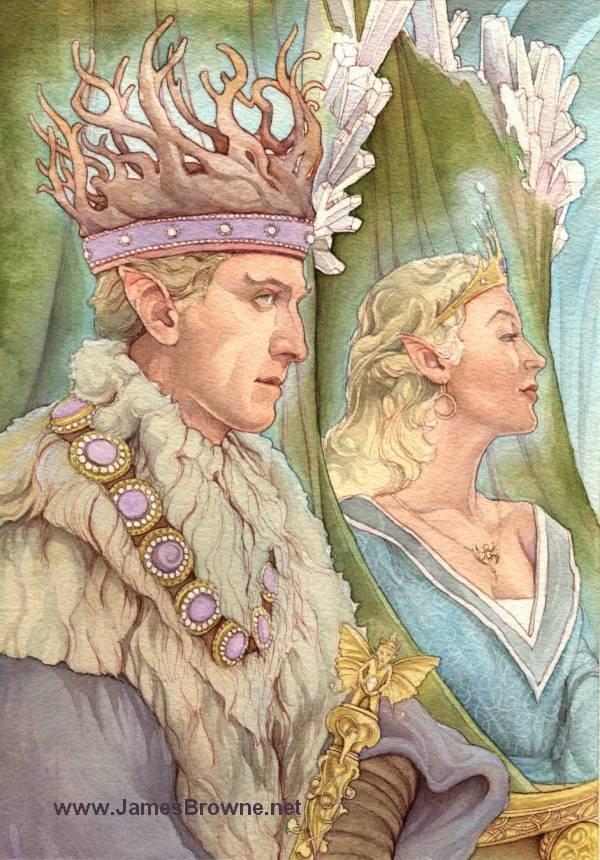The Longaevi of the Middle Ages were what we call elves, sprites, fairies. Creatures that were not of this world yet not of the heavens. Some regarded the elves as the third of the Angels that did not rebel but did not side with God and thus were thrust from Heaven. They would not go to hell but would face Judgement Day.
Others that they were something higher than man but less than God or even a separate creation all together. Children of Lilith or the dirty children of Eve that she hid from God when he came to inspect them.
Whatever they were they were much more feared part of life in earlier times. Beowulf speaks of Elves and Giants and Orcneas (orcs). While elves, and giants are pretty standard in the way that we think of them the orcs were a different critter altogether. They were more like undead vampires living in the corpses of drowned men.
The Norse spread their ideas of the elves throughout wherever they settled or raided and those ideas mixed with indigenous ideas and concepts of the fairy realm. These longaevi or 'long lived' have a corollary in every in every culture I know of. Every culture I am aware of or studied has their own equivalent of elves, giants, fae, etc.
What should they be in roleplaying games?
First, I don't think that unless you are playing a Tolkien inspired game your elves should be Tolkien's elves. Not that I do not love Tolkien's elves. They are the finest in all literature but they are not elves. Not elves in the sense of Ljósálfar or Dökkálfar or the nisse of the Norse. Tolkien's elves are prelapsarian man before the fall of Adam. They are so not elves that 'high men' are often mistaken for elves. Elves aren't recognized by their donkey ears but by the light in their eyes and the ring in their voices. They are so shining with the Holy Spirit that the most powerful can drive away the Nazgul by their mere presence or face Balrogs of Morgoth down in battle.
Tolkien elves, cool as heck, something to look up to, powerful and strong physically, mentally and spiritually but not fairy. Not elves as we mean in D&D or any other OSR. Tolkien games excepted.
Next in literature we come to the quintessential D&D elf. Poul Anderson's elves from 'The Broken Sword'. These are soulless creatures that other than stature look exactly like the elves in D&D. Pointy donkey ears, strange eyes, long lived but amoral interested in magic and power rather than living a life in tune with God's plan. Imric the Elfking from The Broken Sword is what a player character elf could wind up like if he lived long enough and adventured hard enough.
Cooler than that is Anderson's take on mythology. And boy did he know his mythology. He accepted everything and the kitchen sink as 'real'. Not only are the Elves of England and the Alfar of Norse real but the Elves of France, the Tuatha Dé Danann of Ireland etc. The plot is rich and powerful and the elves are different, unique, utterly divorced from human thought but still deeply desiring human children. The magics they work are foul, and beautiful and amazing and they are as 'cruel as cats' but still powerfully interesting protagonists.
I had a long conversation about this book with him thirty some years ago mostly because I am really as big as my namesake and I looked like a viking biker. Nobody was moving me from the line until I was done talking.
There was some other guy there, S.M. Stirling or something like that. I think he wrote a couple books after that. I spent a long time talking to him as well and it was worth it. He knew what I would like just by talking to me about what I liked with Anderson's work.
Anyway my take away on Anderson's work is that for any dungeon master you can find a type or types of elves that fit with your game system. If you want elves that are not just pointy eared hippies, you need some meat and bones behind them. You need to build the folklore and myth into something that is different and spooky.
One of the things that D&D did was remove one of the more common skin colors for critters for fae, green. Green used to be a fairly common skin color in folk lore.

Elves are a part of human history for as long as we can remember. We have several ideas about them and several different takes on them some games embrace that. When I play Dungeon World I encourage my 'elf' players to tell me what makes them 'elves'. In my games every kind of elf is possible from the pointy eared Imric the Elfking types to the human looking Tuatha Dé Danann. Mechanics might be the same for the game (or might not) but I want to know what their vision of what an elf is.
If they say, "D&D elf" great. It is a standard trope with a long history that everyone knows what they mean. If they tell me they want to play something like a Icelandic elf or a Ljósálfar or Dökkálfar, fantastic. There is something new to explore. If they say they have pointy ears, cool, round ears, cool, green hair, skin, etc all cool. No matter what they want to play or how they want to play it. It's all good.
For dungeon masters in other systems what does this mean? Well if your game is not flexible, not much. You get a little of the background of some of your fantasy races but you could get as much reading C.S. Lewis or even the wikipedia. For DMs with more flexible systems or who want to make their own PC or NPC races. You should have a better idea of the variety of elves, fae, fee, alfar etc out there. With a little retooling many creatures like huldra folk can make interesting elves even dark elves.


Norse separate elves into light and dark. Do they have pointy ears? That's up to the DM. Norse light elves live in a realm not far from the gods and are 'as fair as the sun' to look upon. Dark elves live deep underground and are as 'black as pitch'. How you fit your elves into your games is up to you and your player. Just be aware that the original elves were dangerous, magical, different, and inhuman, just the way a player character or non-player character race ought to be.
If you like what you read let me know in the comments.
The pictures and images are the sole property of whomever owns them I make no claim on the images nor intend any infringement of copyright.
Norse dark elves are sometimes translated as dwarves and some mythological experts suspect that they were actually the same mythological creature...Dwarfs occupy a really small place in Norse mythology anyway as at he maker of magical items.
ReplyDeleteThe thing that actually captures the spirit of the elves or fae as understood by folklore bestis the modern myth of alien and alien abduction. These creatures were alien, strange and simply could not be understood or predicted..
Sort of like Lovecraft's Mi-Go. I take my friendly D&D elf any day...
Yes, I think I will be expanding on the subject. The dark elves might be dwarves. As a rule of cool though I am going to be treating them as different. Because I can lol.
DeleteI actually wrote a college paper linking the phenomenon of elves, witch hysteria, and yup alien abduction/experimentation. God help me. I got an 'A' on it. There really are a lot of parallels and if you were the conspiracy minded type of guy it might make you think.